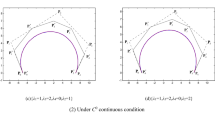Abstract
We decompose the problem of the optimal multi-degree reduction of Bézier curves with corners constraint into two simpler subproblems, namely making high order interpolations at the two endpoints without degree reduction, and doing optimal degree reduction without making high order interpolations at the two endpoints. Further, we convert the second subproblem into multi-degree reduction of Jacobi polynomials. Then, we can easily derive the optimal solution using orthonormality of Jacobi polynomials and the least square method of unequally accurate measurement. This method of ‘divide and conquer’ has several advantages including maintaining high continuity at the two endpoints of the curve, doing multi-degree reduction only once, using explicit approximation expressions, estimating error in advance, low time cost, and high precision. More importantly, it is not only deduced simply and directly, but also can be easily extended to the degree reduction of surfaces. Finally, we present two examples to demonstrate the effectiveness of our algorithm.
Similar content being viewed by others
References
Ahn, Y.J., Lee, B.G., Park, Y., Yoo, J., 2004. Constrained polynomial degree reduction in the L 2-norm equals best weighted Euclidean approximation of Bézier coefficients. Computer Aided Geometric Design, 21(2):181–191. [doi:10.1016/j.cagd.2003.10.001]
Borwein, P., Erdelyi, T., 1995. Polynomial and Polynomial Inequalities (1st Ed.). Springer-Verlag, Berlin.
Chen, G.D., Wang, G.J., 2002. Optimal multi-degree reduction of Bézier curves with constraints of endpoints continuity. Computer Aided Geometric Design, 19(6):365–377. [doi:10.1016/S0167-8396(02)00093-6]
Dannenberg, L., Nowacki, H., 1985. Approximate conversion of surface representations with polynomial bases. Computer Aided Geometric Design, 2(1–3):123–132. [doi:10.1016/0167-8396(85)90015-9]
Eck, M., 1993. Degree reduction of Bézier curves. Computer Aided Geometric Design, 10(3–4):237–257. [doi:10.1016/0167-8396(93)90039-6]
Eck, M., 1995. Least squares degree reduction of Bézier curves. Computer-Aided Design, 27(11):845–851. [doi:10.1016/0010-4485(95)00008-9]
Farin, G., 1983. Algorithms for rational Bézier curves. Computer-Aided Design, 15(2):73–77. [doi:10.1016/0010-4485(83)90171-9]
Forrest, A.R., 1972. Interactive interpolation and approximation by Bézier polynomials. The Computer Journal, 15(1):71–79.
Hoschek, J., 1987. Approximation of spline curves. Computer Aided Geometric Design, 4(1–2):59–66. [doi:10.1016/0167-8396(87)90024-0]
Lachance, M.A., 1988. Chebyshev economization for parametric surfaces. Computer Aided Geometric Design, 5(3):195–208. [doi:10.1016/0167-8396(88)90003-9]
Lodha, S., Warren, J., 1994. Degree reduction of Bézier simplexes. Computer-Aided Design, 26(10):735–746. [doi:10.1016/0010-4485(94)90012-4]
Moore, D., Warren, J., 1991. Least-squares Approximations to Bézier Curves and Surfaces. In: Arvo, J. (Ed.), Graphics Gems II. Academic Press, New York, p.406–411.
Rababah, A., Lee, B.G., Yoo, J., 2006. A simple matrix form for degree reduction of Bézier curves using Chebyshev-Bernstein basis transformations. Appl. Math. Comput., 181(1):310–318. [doi:10.1016/j.amc.2006.01.034]
Rababah, A., Lee, B.G., Yoo, J., 2007. Multiple degree reduction and elevation of Bézier curves using Jacobi-Bernstein basis transformations. Numer. Funct. Anal. Optim., 28(9–10):1179–1196.
Sunwoo, H., 2005. Matrix representation for multi-degree reduction of Bézier curves. Computer Aided Geometric Design, 22(3):261–273. [doi:10.1016/j.cagd.2004.12.002]
Watson, G.A., 1980. Approximation Theory and Numerical Methods. John Wiley & Sons, Chichester.
Zhang, R.J., Wang, G.J., 2005. Constrained Bézier curves’ best multi-degree reduction in the L 2-norm. Progr. Nat. Sci., 15(9):843–850. [doi:10.1080/10020070512331343010]
Zheng, J.M., Wang, G.Z., 2003. Perturbing Bézier coefficients for best constrained degree reduction in the L 2 norm. Graphical Models, 65(6):351–368. [doi:10.1016/j.gmod.2003.07.001]
Author information
Authors and Affiliations
Corresponding author
Additional information
Project supported by the National Natural Science Foundation of China (No. 60873111) and the National Basic Research Program (973) of China (No. 2004CB719400)
Rights and permissions
About this article
Cite this article
Zhou, L., Wang, Gj. Optimal constrained multi-degree reduction of Bézier curves with explicit expressions based on divide and conquer. J. Zhejiang Univ. Sci. A 10, 577–582 (2009). https://doi.org/10.1631/jzus.A0820290
Received:
Accepted:
Published:
Issue Date:
DOI: https://doi.org/10.1631/jzus.A0820290




